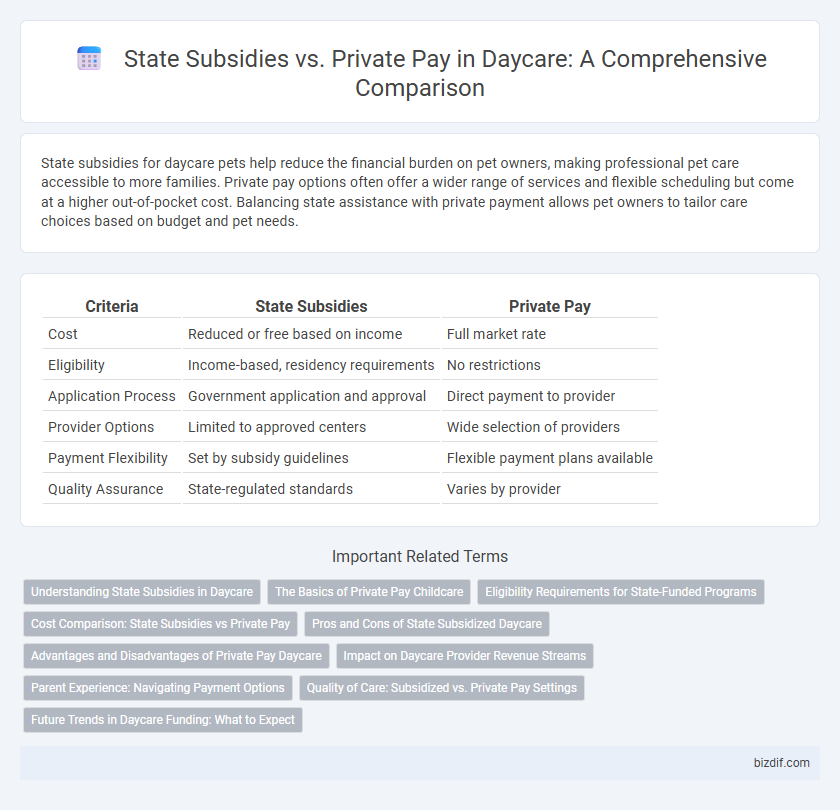State subsidies for daycare pets help reduce the financial burden on pet owners, making professional pet care accessible to more families. Private pay options often offer a wider range of services and flexible scheduling but come at a higher out-of-pocket cost. Balancing state assistance with private payment allows pet owners to tailor care choices based on budget and pet needs.
Table of Comparison
| Criteria | State Subsidies | Private Pay |
|---|---|---|
| Cost | Reduced or free based on income | Full market rate |
| Eligibility | Income-based, residency requirements | No restrictions |
| Application Process | Government application and approval | Direct payment to provider |
| Provider Options | Limited to approved centers | Wide selection of providers |
| Payment Flexibility | Set by subsidy guidelines | Flexible payment plans available |
| Quality Assurance | State-regulated standards | Varies by provider |
Understanding State Subsidies in Daycare
State subsidies for daycare reduce the financial burden on low- and moderate-income families by covering part of the childcare costs, enabling access to quality early education. These subsidies often require eligibility verification based on income, employment status, and sometimes child age, with state-specific application processes and funding limits. Understanding the differences in funding amounts and waitlist policies between subsidized and private-pay daycare options helps families make informed decisions about affordable childcare choices.
The Basics of Private Pay Childcare
Private pay childcare requires families to cover the full cost of care, which varies widely based on location, provider, and the child's age, often ranging from $9,000 to $22,000 annually in the United States. Unlike state-subsidized programs, private pay options typically offer greater flexibility in choosing providers and care schedules but do not receive government funding or financial assistance. Understanding local market rates and the types of childcare services available can help parents make informed decisions about private pay childcare expenses.
Eligibility Requirements for State-Funded Programs
State-funded daycare programs typically require families to meet specific income thresholds, residency status, and work or school participation criteria to qualify for subsidies, ensuring assistance targets low-to-moderate income households. Documentation such as proof of income, identification, and employment or educational enrollment verification is essential for eligibility assessment. These programs aim to increase access to affordable childcare, reducing financial burden and promoting early childhood development.
Cost Comparison: State Subsidies vs Private Pay
State subsidies significantly reduce the out-of-pocket costs for daycare, making quality childcare more accessible to low- and middle-income families. Private pay rates, often influenced by location and facility quality, tend to be substantially higher, sometimes doubling the expense compared to subsidized care. Families utilizing state subsidies benefit from capped fees aligned with household income, whereas private payers face full market rates without financial assistance.
Pros and Cons of State Subsidized Daycare
State subsidized daycare offers affordable childcare options for low-income families, increasing accessibility and supporting early childhood education. However, limited funding may lead to longer waitlists and less flexibility in hours or provider choice compared to private pay options. Quality can vary depending on state regulations, making it essential for parents to research local programs thoroughly.
Advantages and Disadvantages of Private Pay Daycare
Private pay daycare offers flexibility in choosing specialized programs and higher staff-to-child ratios, often leading to enhanced care quality and individualized attention. However, these benefits come at a higher cost, which can limit accessibility for many families compared to state-subsidized options. Unlike state subsidies that require income verification and eligibility criteria, private pay allows unrestricted enrollment but poses financial challenges that may impact long-term affordability.
Impact on Daycare Provider Revenue Streams
State subsidies provide consistent funding that enhances daycare provider revenue stability, allowing for more predictable budgeting and sustained service quality. In contrast, private pay relies on fluctuating family incomes, leading to variable cash flow and potential revenue gaps during economic downturns. Balancing these revenue streams is critical for daycare providers to maintain operational efficiency and invest in staff development.
Parent Experience: Navigating Payment Options
Parents navigating daycare payment options often weigh state subsidies against private pay, as state subsidies can significantly reduce out-of-pocket costs, improving affordability for low- to moderate-income families. Accessing state subsidies requires understanding eligibility criteria and application processes, which may vary by region and impact the overall parent experience. Private pay offers more flexibility in selecting providers but comes with higher and less predictable expenses, influencing decisions based on budget and care preferences.
Quality of Care: Subsidized vs. Private Pay Settings
State-subsidized daycare programs often face stricter regulations and lower staff-to-child ratios, promoting consistent quality of care compared to some private pay settings. Private pay daycare centers may offer enhanced resources and specialized programs due to higher fees but can vary widely in quality depending on ownership and management. Research indicates that while subsidized centers provide reliable foundational care, private pay facilities tend to excel in individualized attention and extracurricular enrichment when well-funded.
Future Trends in Daycare Funding: What to Expect
State subsidies for daycare are projected to increase as governments prioritize early childhood education and aim to make care more affordable for low- and middle-income families. Private pay options will continue to offer premium services, catering to families seeking specialized programs and flexible hours, with rising costs reflecting inflation and quality enhancements. Emerging models combining public funding with private partnerships are expected to expand, promoting innovation and accessibility in the daycare sector.
State subsidies vs private pay Infographic

 bizdif.com
bizdif.com